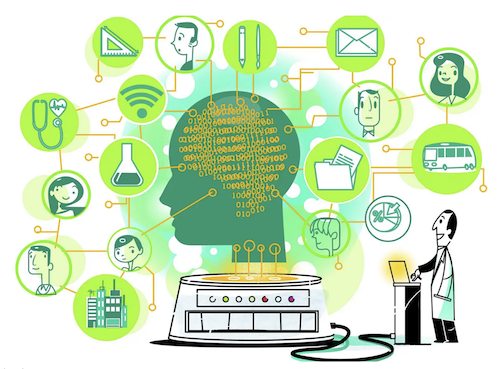According to Rémy Touguay, a Graphics Industry Teacher, Trainer and Software R&D Director, in recent years, and more recently with the advent of the chatGPT robot, artificial intelligence has been increasingly integrated into our professional and personal lives. However, there is a shortage of human resources needed for the proper functioning of graphic industry companies.
The graphic arts professions no longer attract the interest of young people, even though the sector has undergone significant evolution with digitalisation and automation. The industry is facing considerable challenges.
In terms of artificial intelligence, it is essential to remember that human intelligence will be needed to manage printing operations, whether it’s in the upstream design phase, during production, or for the management and maintenance of production tools.
Equipment, processes, and computer tools are constantly evolving, making production tasks increasingly accessible to ‘humans’. Today, it is no longer necessary to be a 100kg giant to operate an offset press. However, it is important to emphasise that humans remain essential in the implementation of production processes, and fortunately, this is the case. This is evident, particularly in the training provided by suppliers when acquiring new production equipment: owning the tool is not enough; one must also possess the necessary human skills to use it correctly.
Furthermore, the qualification of operators, drivers, and managers who use these tools, which increasingly integrate automation, robotics, and assistance systems, requires a high level of skills. Artificial intelligence cannot (yet) function without the human input that enables its proper use.
Artificial intelligence already allows, to a large extent, the synthesis and utilisation of vast amounts of data (management, production, etc.) to improve production processes and quality. In this regard, there is no doubt that this will also be evident at drupa 2024. Therefore, it is essential for employees, regardless of their responsibilities within the company, to learn how to question and properly navigate these intelligent tools, knowing what and how to interrogate them, as well as being able to analyse the collected and processed data to derive concrete recommendations. Ultimately, decisions need to be made, which is imperative but not necessarily simple.
Indeed, the question of the availability of skills required to use connected artificial intelligence tools arises. In terms of education and training, it is observed that young people are showing less and less interest in careers in the industry in general, including those in the graphic arts and printed communication sectors.
What Is Happening, What Has Happened?
The first observation is at the level of companies. A significant change in mindset has occurred over the past 20 years: previously, the majority of printers’ children pursued studies that allowed them to continue on the same path as their parents. They were motivated and had a particular interest in these fields. They could be found in schools and training institutes where they acquired the necessary technical and complementary skills. Business was thriving, with high profit margins promising a bright future in the family business.
Today, an increasing number of company leaders have more experience in commerce, management and production management. In the past, it was often technicians who started their activities based on their know-how and passion. Now, as mentioned earlier, given the current context, one needs to be a seasoned manager for the company to be profitable and generate benefits.
Generally, today’s printers no longer extol the virtues of their profession to their families. Profit margins have significantly declined since the 2000s, making profitability challenging, and the prospects lean more towards consolidation under the control of large groups. Consequently, it is other groups of young people who are entering the graphic arts sector, often discovering this industry completely.
Secondly, in terms of future employees: the younger generation, Generation Z, has a different vision of the world and work today. Many companies have not yet taken this change in perception into account. To make jobs attractive, companies need to revise their management style, integration methods and attraction of new employees by adapting to their new demands. These young individuals were born with screens, no longer consider work as a priority, and prioritise factors such as working conditions, well-being, and family. Various studies conducted in different countries all arrive at similar conclusions.
The third observation is the level of training programmes. Are the programmes offering education in the graphic industries still suitable? Are they adapting to the rapid evolutions in the sector, the jobs of tomorrow (training of trainers and teachers in schools, institutes, universities), the behavioural changes of the new generations (use of digital tools, time management, schedules, etc.), and the integration of new artificial intelligence tools made available to the general public for the acquisition of necessary knowledge and skills?
The challenge is clear: it is about attracting young people and talent so that companies can continue to thrive. Intergraf, through the Print Your Future Awards competition, has been studying this issue for several years in collaboration with partners such as federations, institution, and professional associations. They have already identified the situation and implemented actions to enhance attractiveness. In France, a recent initiative by a professional association (CCFI) aims to bring together stakeholders from the industry (employer federations, labour unions, suppliers, training providers, press, etc.) to develop a joint action plan to improve recruitment and meet the human resources needs in the sector.
The issue of recruitment and attractiveness of the industry is closely linked to the image of graphic arts professions. The sector is often poorly understood or even unknown to the general public. If you were to ask people with no professional or family ties to the graphic arts industry, you would find a perception of an outdated image, referring to Gutenberg and past centuries, that does not convey career opportunities. Furthermore, this industry under pressure is often associated with topics such as the decline of daily press and print media in general, which contrasts with the growth of digital platforms. Moreover, this industrial sector is seen as polluting and environmentally unfriendly due to the paper production’s perceived pollution.
Drupa is an opportunity for printers to exhibit industry transformations and showcase new trends that have taken the industry far from the era of Gutenberg. Industry events should undoubtedly be an opportunity to raise public awareness of the sector through media, press, social media platforms, etc. to showcase the technological level required for producing printed products worldwide. It is essential to emphasise that these professions require skills, knowledge, and will continue to exist in the future, with automation levels at least as advanced as in other industries.
It is up to us stakeholders in the graphic arts industry to make known that these professions are associated with innovation in various forms, including the integration of AI tools in the production process. We need to promote international events and, if done effectively, we will attract future generations of talented individuals.
DRUPA
https://www.drupa.com














